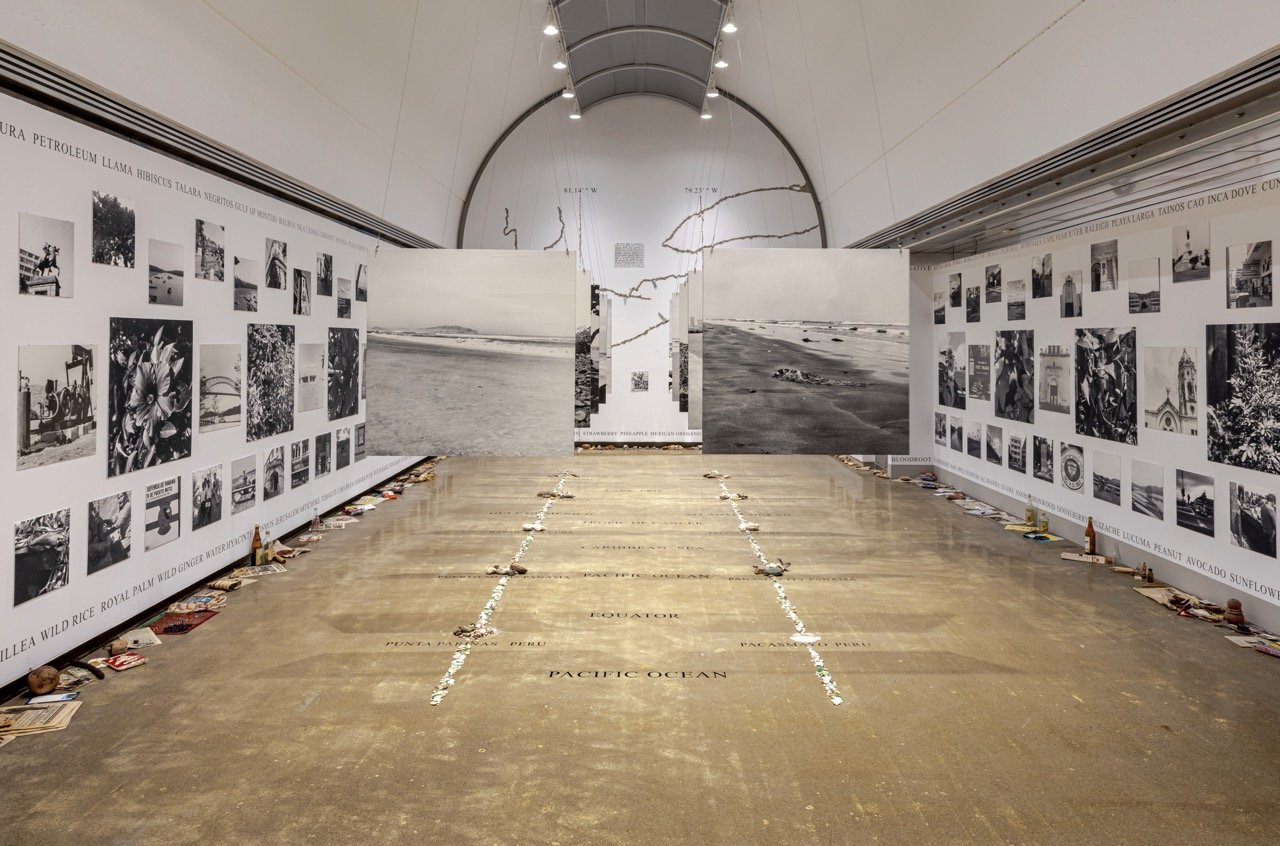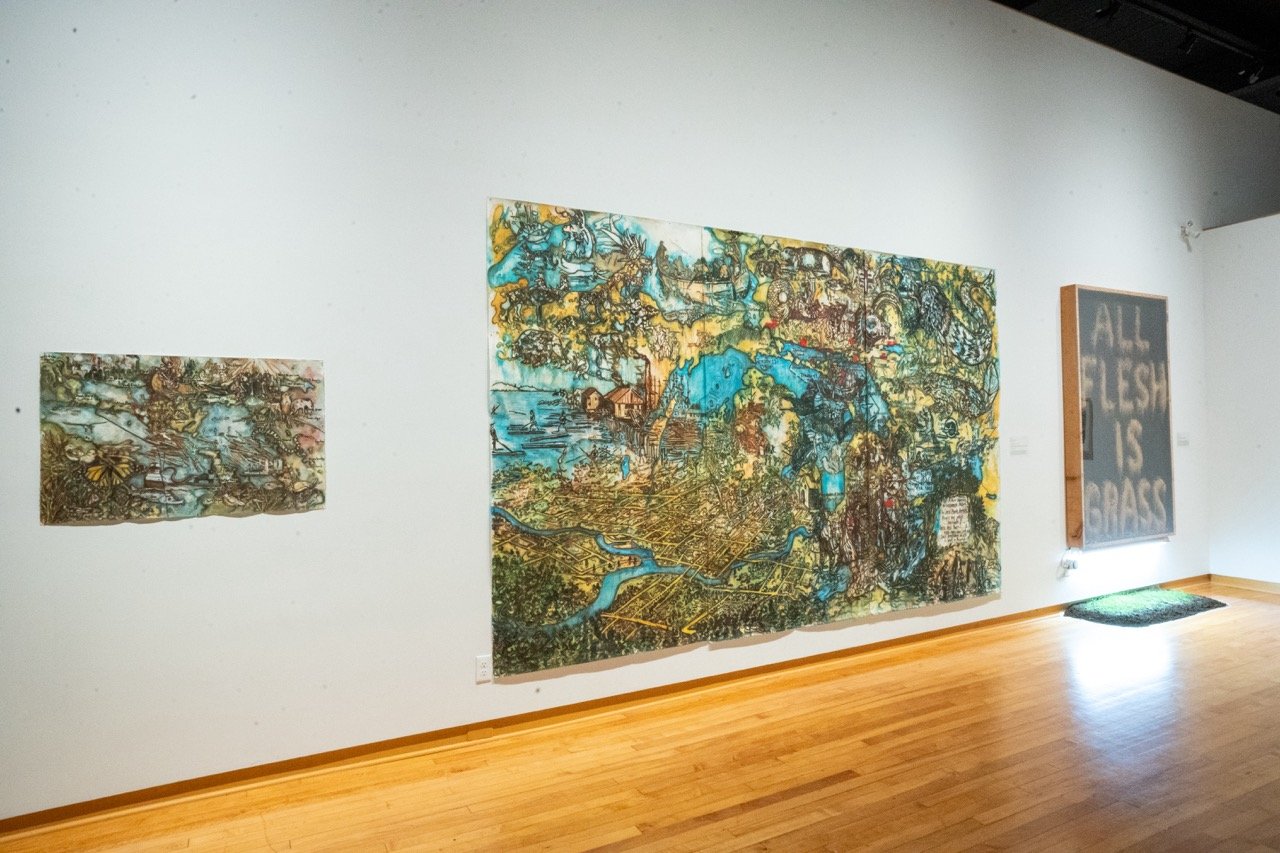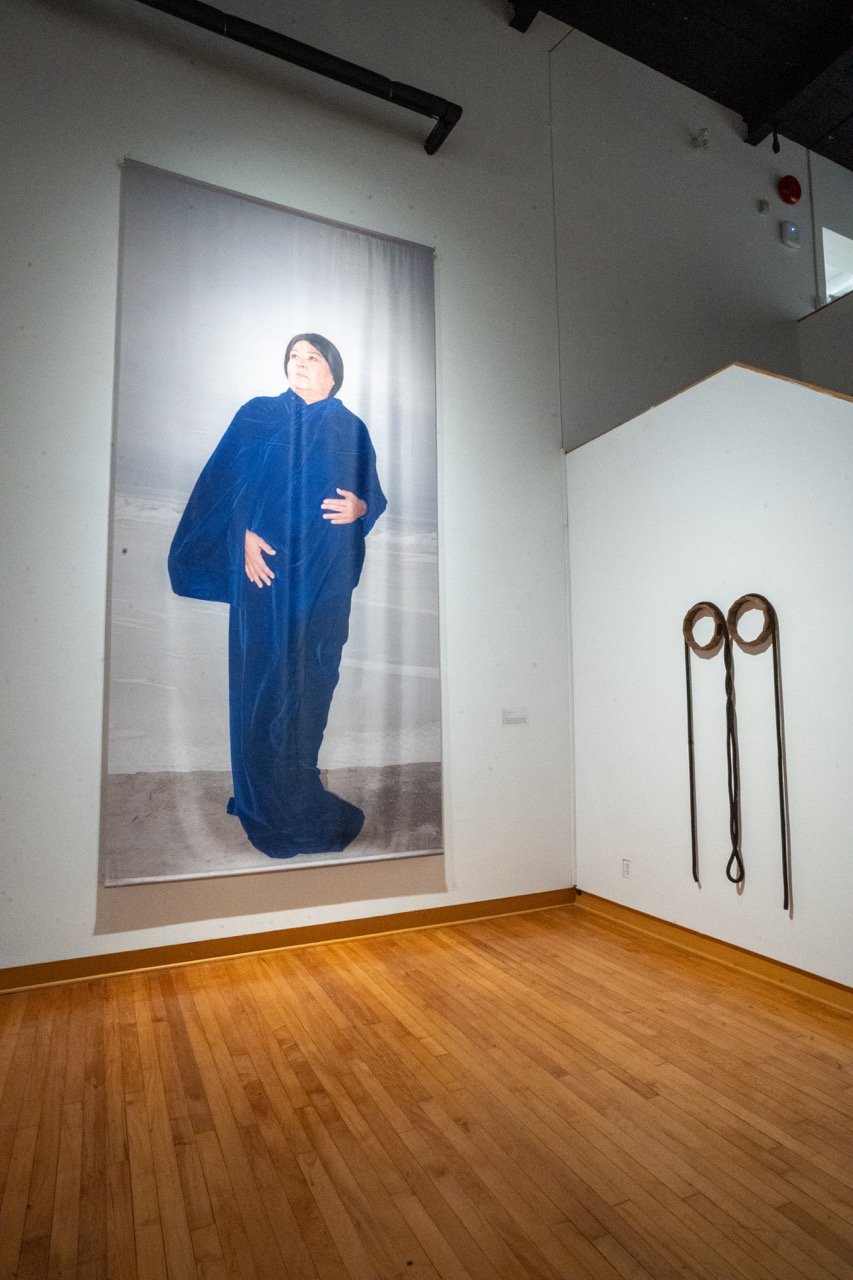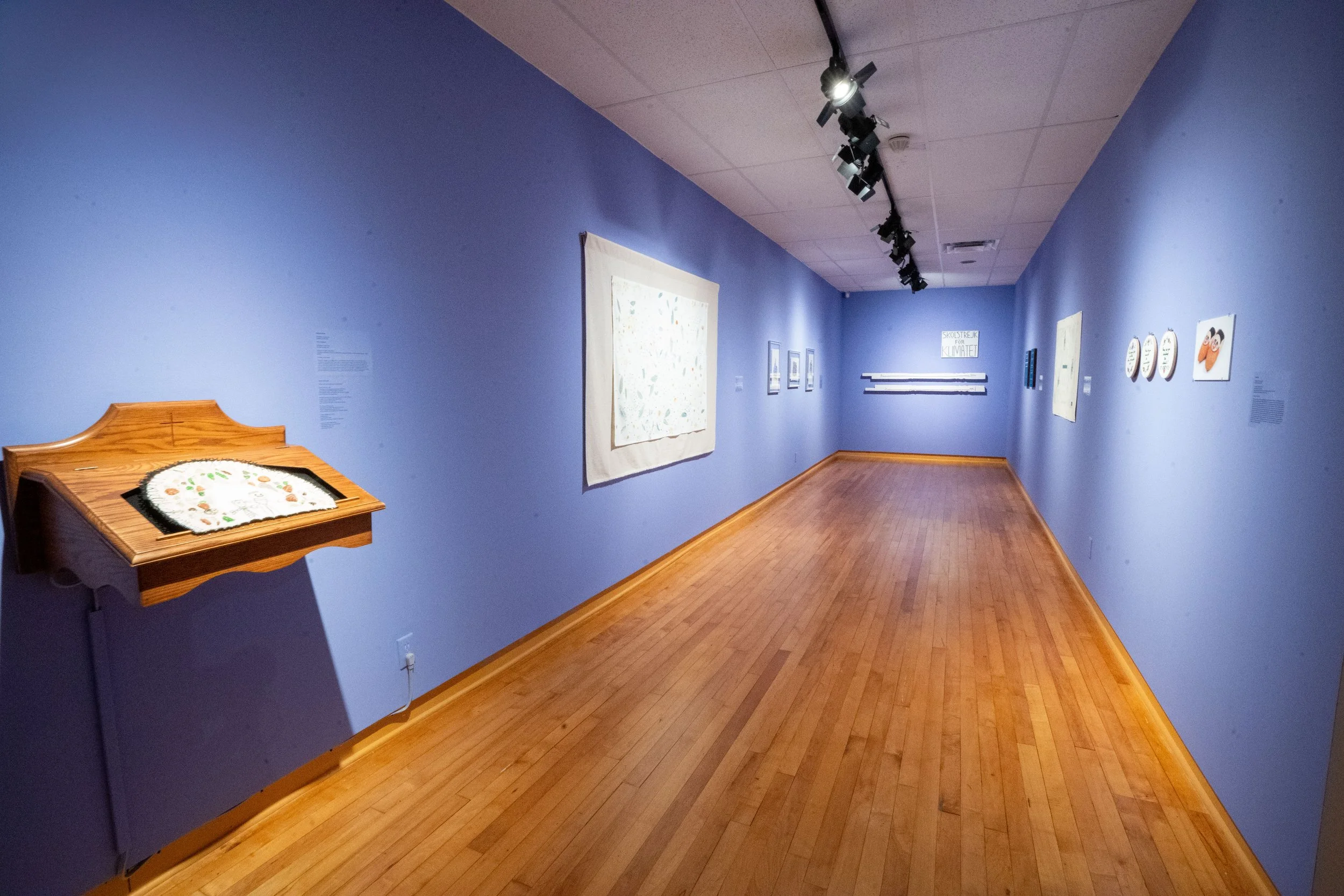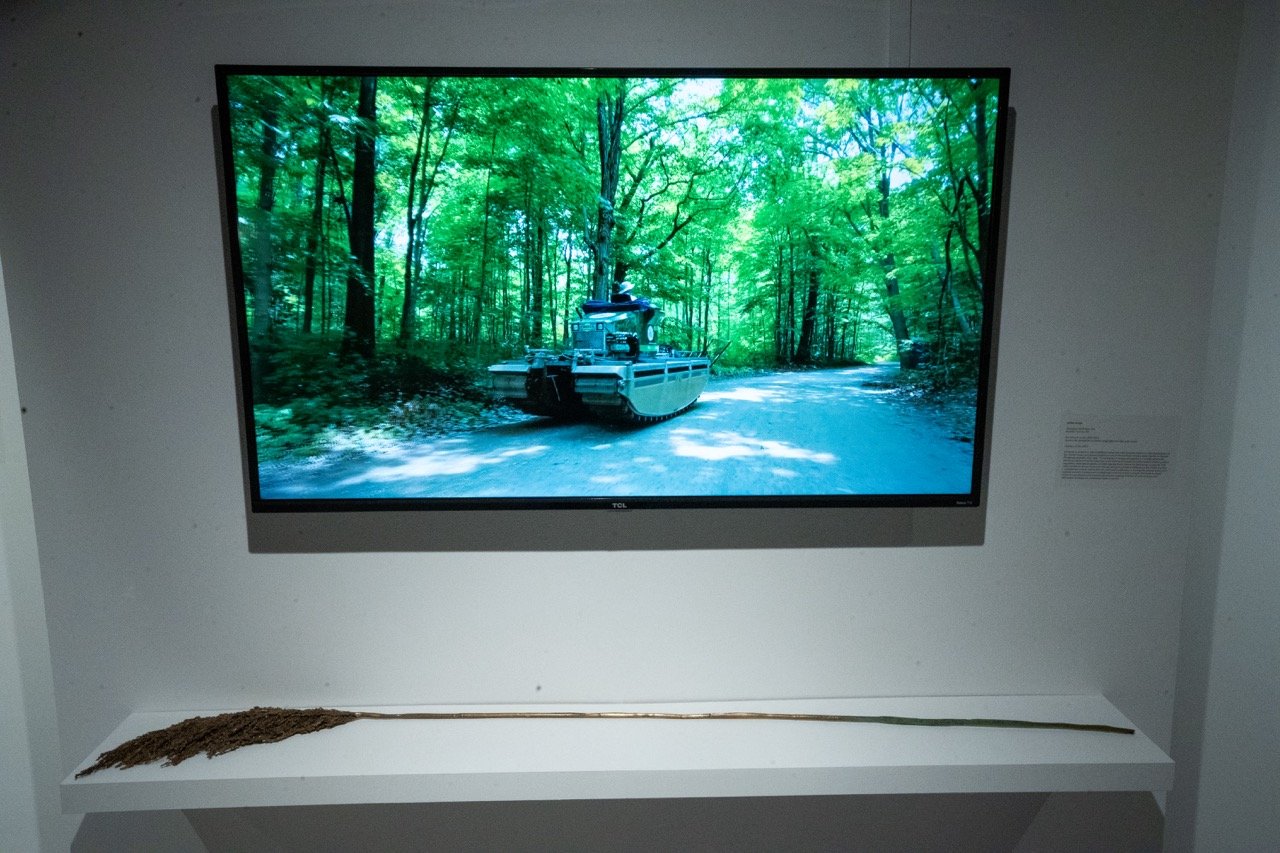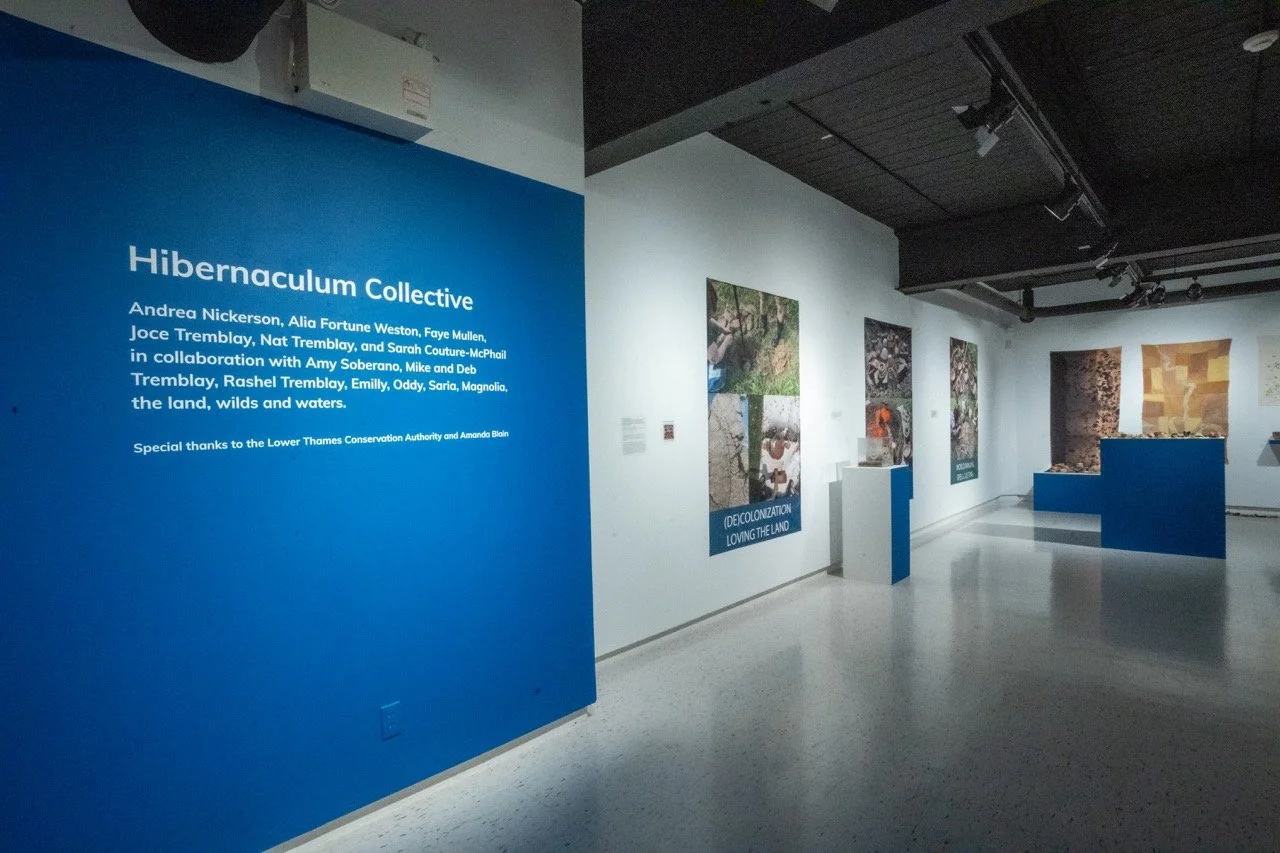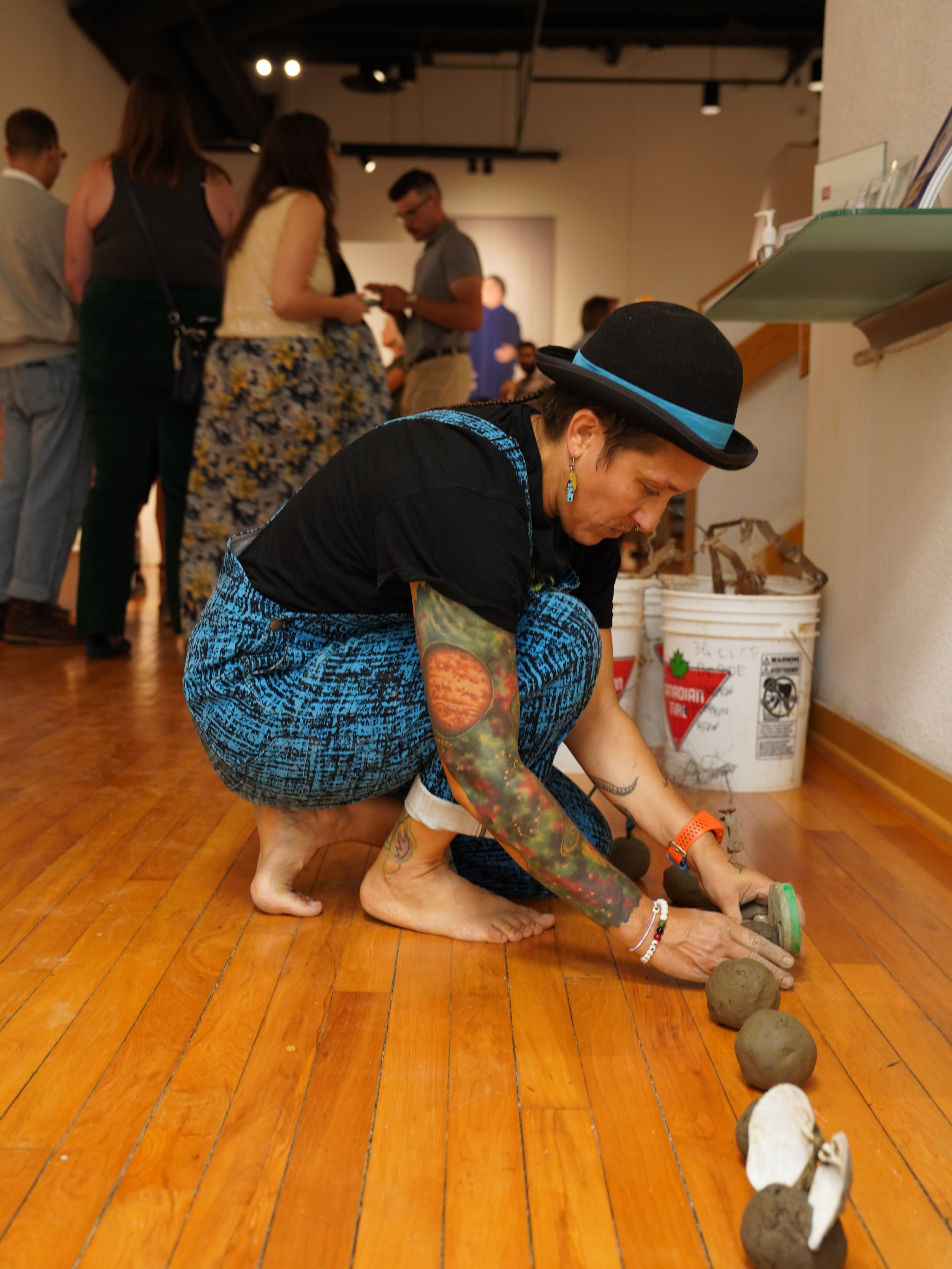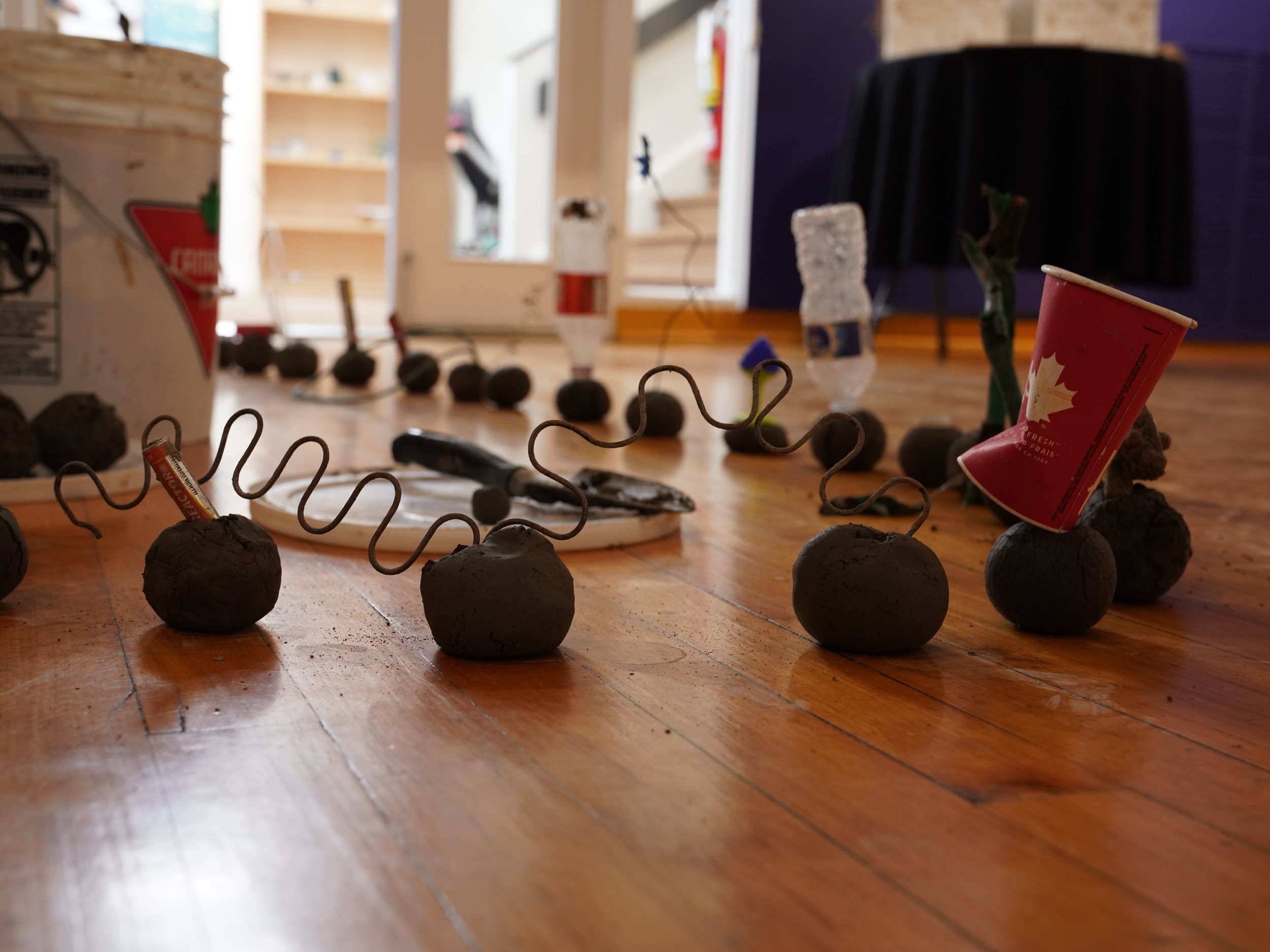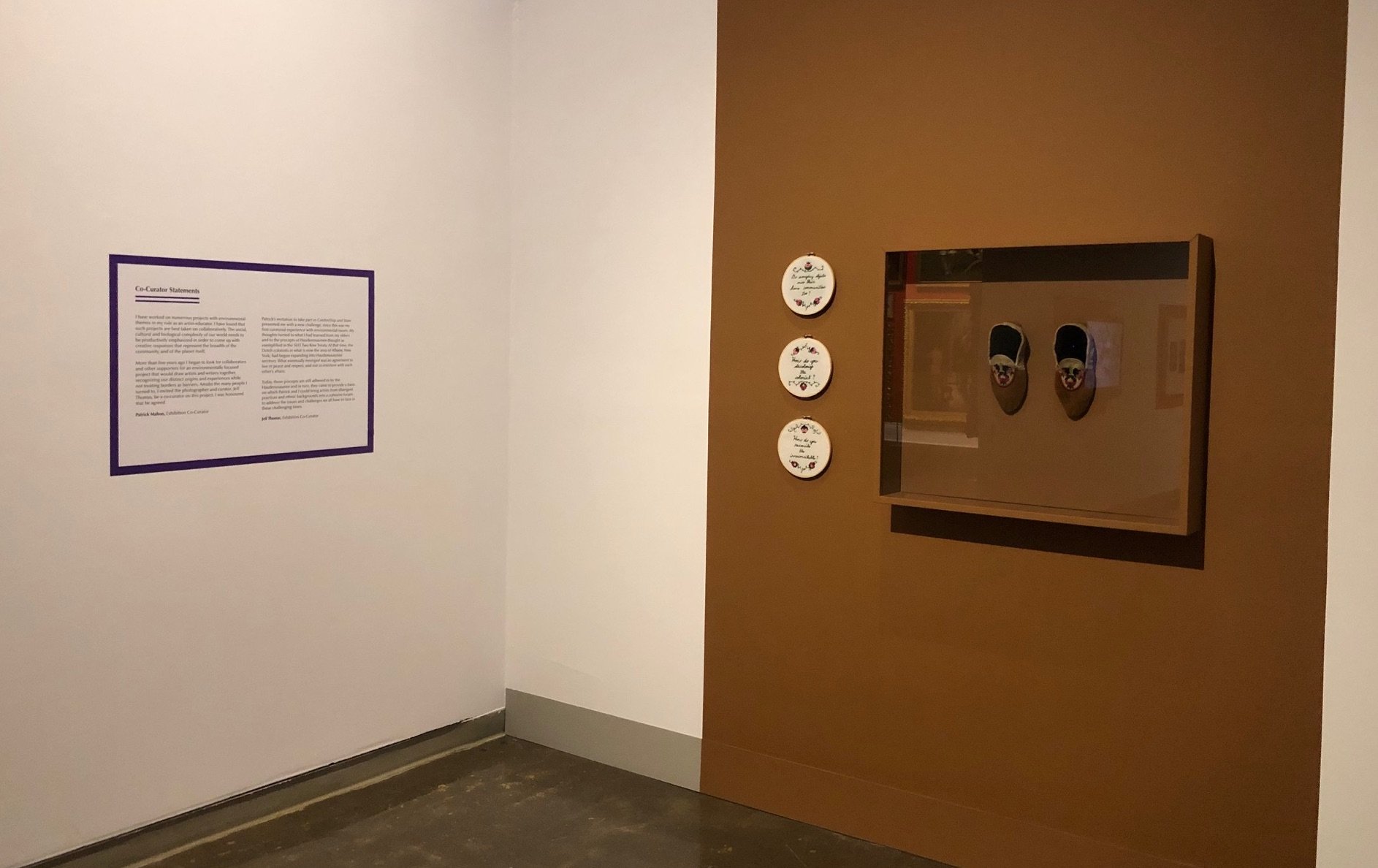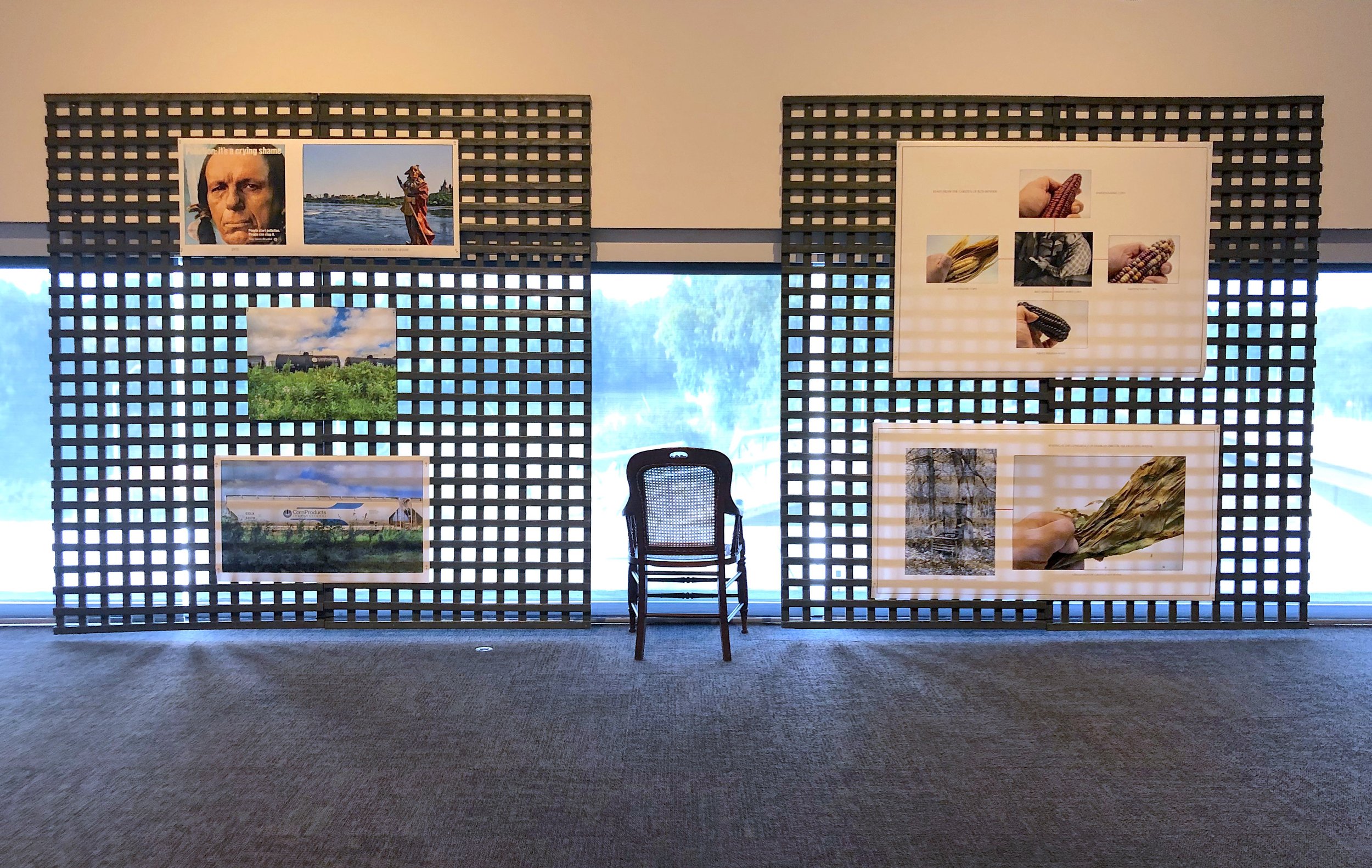
Exhibitions
The two exhibitions, presented in 2020-21 and in 2024, emerged from an artistic research plan that spanned approximately five years. We began by seeking collaborators and supporters, artists and writers, to participate in, and lend voice to a cross-disciplinary project addressing what is arguably the problem of our times: environmental catastrophe. The result is GardenShip and State, showcased at Museum London, and later, the Thames Art Gallery, Chatham, ON.
Museum London is located on a site of intersection, at the forks of the Deshkan Ziibi, also known as the Thames River. GardenShip and State is, similarly, an expression of confluence. It brings together a diverse group of 20 artists and writers from Turtle Island: from areas within Canada and the United States. Through work comprising textiles, photography, sculpture, video, gardening, and installation, the artists in this exhibition engaged issues of decolonial critique, environmental activism, and protest against government and industry complicity in the ongoing climate crisis. GardenShip and State invites audiences to engage with aesthetically rich and culturally complex artworks that are provocative, challenging, and also sources of hope.
GardenShip and State asks how people can work together, as a global community, toward restoring the planet—while respecting differences, and seeking to mend divisions and address injustices brought about by colonialism.
In its two iterations, the exhibition was addended by other projects and programs: a Conference and Community Gathering (Confluences, Museum London,2023; see Projects on this website). And at Thames Art Gallery, the work of the Hibernaculum Collective and an accompanying Performance were presented alongside our exhibition (see photographs below and link on Projects Page).
Join curators Jeff Thomas and Patrick Mahon on a tour through "GardenShip and State”, at Museum London, 2021-22. Twenty contemporary artists explore proposals to to restore the planet through contemporary artworks which emphasize respecting differences, repairing divisions, and addressing injustices brought about by colonialism.
Museum London
Oct. 2021-Jan. 2022 – Exhibition Installation
Thames Art Gallery
August - October 2024 – Exhibition Installation
Co Curators’ Statements
“I have worked on numerous projects with environmental themes in my role as an artist-educator. I have found that such projects are best taken on collaboratively. The social, cultural and biological complexity of our world needs to be productively emphasized in order to come up with creative responses that represent the breadth of the community, and of the planet itself.
More than five years ago I began to look for collaborators and other supporters for an environmentally focused project that would draw artists and writers together, recognizing our distinct origins and experiences while not treating borders as barriers. Amidst the many people I turned to, I invited the photographer and curator, Jeff Thomas, be a co-curator on this project. I was honoured that he agreed.
As you will see, GardenShip and State comprises works made with textiles, photography, sculpture, video, gardening, and installation, and invites us to engage with aesthetically rich and culturally complex artworks that are both provocative and challenging, and also sources of hope.”
-- Patrick Mahon, Exhibition Co-Curator
“Patrick’s invitation to take part in GardenShip and State presented me with a new challenge, since this was my first curatorial experience with environmental issues. My thoughts turned to what I had learned from my elders and to the precepts of Haudenosaunee thought as exemplified in the 1613 Two Row Treaty. At that time, the Dutch colonists in what is now the area of Albany, New York, had begun expanding into Haudenosaunee territory. What eventually emerged was an agreement to live in peace and respect, and not to interfere with each other’s affairs.
Today, those precepts are still adhered to by the Haudenosaunee and in turn, they came to provide a basis on which Patrick and I could bring artists from divergent practices and ethnic backgrounds into a cohesive forum to address the issues and challenges we all have to face in these challenging times.”
-- Jeff Thomas, Exhibition Co-Curator
The GardenShip Journal
The GardenShip Journal was created by project collaborators Tom Cull, Amelia Fay, Joan Greer, and Andrés Villar, and designed by Katie Wilhelm, as a personal guidebook and a space for reflecting upon and engaging with the works and themes of the exhibition. It is available in print within the exhibition, as well as at the Central Branch of the London Public Library, within Mary Mattingly's Ecotopian Library installation. In that location, all are welcome to pick up a corn seed packet for planting in their home garden.
Contributors at Museum London
Ron Benner
As The Crow Flies, 1984-1991
“Ron Benner’s multi-media installation As The Crow Flies follows meridians of longitude south from London, Ontario and Toronto, Ontario. The work provides glimpses of the interconnected organic and inorganic matter that forms these sites. “The names of native American plants, place names and Indigenous nations found along the two longitudes border the perimeter of the space top and bottom. This work offers an alternative vision of what lies due south of London and Toronto, Ontario.”
Lori Blondeau
Iskwew on Lake Winnipeg, 2018
Lori Blondeau offers the following about her work, “Storytelling has influenced every aspect of my practice, and makes up a lot of what I produce visually. I take the stories, whether they are old stories or contemporary ones, and make them into visual culture. I see what I do with my art practice as high-tech storytelling in a contemporary time. As an artist who is an Indigenous woman, I cannot help but be influenced by the stories of the day and how they impact my worldview. This work, titled Iskwew on Lake Winnipeg was influenced by my move and family history in Manitoba. The photography and performance personas I create refer to the damage of colonialism and to the ironic pleasures of displacement and resistance.”
Sean Caulfield
Powerlines, 2021
In Powerlines, Sean Caufield considers how we imagine a more just future for and with our children. This series of sculptural 'toys' that references the infrastructure of the fossil fuel industry, includes an oil tanker, oil derrick and military vessel. Alongside these vessels' recognizable contours are several smaller amorphic bodily 'toys.' The work is simultaneously whimsical, absurd, and dark, with an ominous feeling of "consequences we all face if we do not build more sustainable and equal communities."
Paul Chartrand
Desiccated Root Text (and other works), 2021
Paul Chartrand engages with environmental and cultural issues through the construction of sculptural assemblages built from carefully chosen and assembled objects, which he then populates with living plants. Chartrand offers, “I consider the meaningful roles of discrete parts in functioning, living entities. Individually, plants, inanimate objects, or human actions may appear mundane, but when framed in the context of thriving and interconnected webs of being, they become members of a community. For the Gardenship and State project, I wanted to emphasize community in these assemblages as well. How can an artwork act as a focal point and catalyst for social organization and activism? Or act as an ever-changing memorial? Or, as a tangible reminder of the ephemeral nature of life, the written word, and art itself?”
Tom Cull with Danielle Butters & Sruthi Ramanarayanan
UpStream/DownStream,(still), 2020-2021
UpStream/DownStream is a project that brings together art and activism to focus on the question of clean drinking water and healthy river ecology. The work is comprised of two video ‘poems’ that were composed from footage taken at a number of river cleanups held in London, Ontario, and at Oneida Nation of the Thames—two communities that are connected by one river: Deshkan Ziibi/Thames River. Oneida First Nation is currently on a boil-water advisory due, in part, to the ways that the city of London and other upstream communities pollute the river. Volunteers were invited to participate in the cleanups and share their thoughts about what water means to them.
Michael Farnan
A Map Depicting the Settlement History of the Land, Plants, Animals, People, and Water Between Here and There. Here being where I am, and There being where you are. A Work in Progress, 2021
Michael Farnan presents a visual mapping and meditation on the politics of making place and meaning, as a settler, on the land and waters in which the artist lives, works, and travels. He notes, “The map imagery illustrates historical “settlement” narratives (colonial invasion), of the Great Lakes region of Canada, as well as their intersections with (forced) Indigenous displacement (Reservations and Treaties) and the non-human life of bird, fish, and mammal. The video shown represents a moment of reflection on one of the other places I have thought of as home, living and working in the East Kootenay’s, planting trees for the past 25 years. For me, this research is ongoing, vital, and remains a work in progress.”
Amelia Fay
Curating Colonialism, 2021
“My role as Curator of the Hudson’s Bay Company Museum Collection is a challenging one. The collection, established in the 1920s to celebrate the Company’s history, reflects some startling truths about a history of deeply rooted in colonialism and environmental extraction. While roughly two-thirds of the artifacts in the collection were made by First Nations, Inuit, and Métis peoples, the presence of these items reflects the problematic nature of how some of them were acquired. These moccasins provide an example of the everyday objects that make up the majority of the collection, showcasing the beautiful artistry by the maker yet imbued with this complicated history: they are catalogued under the name of the collector (a white man) rather than the Cree woman who crafted them. A name that was never recorded and is now lost. My embroidery, inspired by these moccasins, reflects the struggle I feel as I grapple with the role of museums, collections, and think about how to best serve the objects under my care. My questions aren’t new, unique to me, or this collection, but rather reflect some of the wider challenges museums face today.”
Jamelie Hassan
Gizzard Shad, 2021
This tile mosaic began with a walk to the Deshkan Ziibi to experience the once-in-a-decade swarming of the Gizzard Shad fish at a confluence of warm storm waters and chillier river water. Then, working from a photograph snapped by her partner Ron Benner, Jamelie Hassan responded to the organic swirling forms of the shimmering fish. Her loose, intuitive process for creating this piece has resulted in a work that references a shifting, abstracted memory of a moment with nature. These moments “have been an immense presence and comfort during these months of the COVID-19 pandemic.”
Sharmistha Kar
Home and Land; Soft Shelter – Walking together, 2021
Home and Land, Soft Shelter - Walking together, and Blurred steps III emerge from Sharmistha Kar’s shifting connections to place as she has moved around India and to Canada. They touch on consistent themes in her recent work; migration and resettlement in the wake of colonialism. Kar recognizes this shared history in both of the nations she now calls home. She uses both meticulous embroidery and interventions such as showing the verso (or reverse) to record and make strange the traces colonialism has left on land, culture, and her own lived experience.
Jessica Karuhanga
Blue as the insides, 2021
Shifting between disconnected spaces and moments, Blue as the insides is comprised of innumerable single-frame shots. The video depicts a figure dancing, gesturing and reaching in moments of solitude. The tightly shot images allow the viewer an intimate glimpse of a performance conveying the most personal themes; loneliness, grief, and loss. The lone dancing figure is an affective meditation on solitude in this moment of isolation. In this work, Jessica Karuhanga asks, “What is the efficacy of art in a period riddled with unending uncertainty?”
Mark Kasumovic
Bird Watching Hut, 2021
Mark Kasumovic focuses his attention on a conservation area in the UK, surrounded by heavy refining industries in a lens-based suite of works. The near post-apocalyptic skyline (reminiscent of the film Blade Runner) contrasts with the wind-blasted and foreboding nature visible in Bird Watching Hut. Other photographs in the series "explore the often subtle and quiet ambience of climate change." This searching is underscored in the video Rottnest which, with cinematic flair, follows the work of a team of scientists observing subtle and quiet changes within the landscape.
Patrick Mahon
Threshold Flags: Caledonia Occupation Site – from Photograph by Jeff Thomas (2008), 2021
Patrick Mahon is interested in signs, emblems, and markers of place, as well as for ceremonial and ritual purposes. He notes, “These works based on images involving flags, came about as I was thinking about land, and histories of colonialism, and of important present-day challenges regarding the environment and colonization that we need to work on and understand – including through our use of symbols. Each of the works depicts a context where flags appear at a threshold site of social or historical engagement. I have made the pieces in a manner that both fixes the image physically, and presents it as if in a state of transition. By doing this, I’m asking the viewer to decide if the pictures are coming into focus, or becoming more diffuse, and what that can tell us about the time of transition, transformation and passage we are experiencing.”
Mary Mattingly
Ecotopian Library, 2019 and ongoing
The Ecotopian Library is a public toolkit that stems from a belief that art and ecotopian thought can be part of cultivating systemic social change. It combines disciplines including forestry, botany, geology, the arts, including literature, poetry, philosophy, and social sciences. People have contributed stories, objects, digital files, experiences, or books to build a toolkit that can help expand imaginations to co-build more regenerative futures within climate change.
Quinn Smallboy
Colours – Small Drum Ring, 2021
Lines – Small Drum Ring, 2021
Currently, Quinn Smallboy’s artistic practice investigates what it means to be a ‘contemporary Indigenous artist.’ He says, “Specifically, I question how customary symbols and icons of Indigenous culture translate into painting, sculpture, and installation. These works, entitled Colors – Small Drum Ring, and Lines – Large Drum Ring, are a flip on a familiar shape within Indigenous culture. This idea of flipping or reshaping familiar objects provides a new look at Indigenous storytelling.”
Ashley Snook
the honey is sweet, 2020-2021
the honey is sweet is a video installation where the artist presents evidence of her explorations of the colonial history and growth patterns of one of the foremost invasive plant species in Canada: Phragmites australis. She notes, “The presence of invasive phragmites in Canada reflects the pervasive impact of colonial expansion and industrial processes on southwestern Ontario’s native vegetation, endangered species, and the ongoing threat it poses to biodiversity in Canada. This video installation traces my journey through overgrown Ontario wetlands on the Truxor machine – a phragmites-control vehicle that cuts and removes biomass. In tracing the colonial history of P. australis arrival in Canada and investigating current treatment methods, the honey is sweet invites the questioning of environmental decision-making, in favour of more inclusive and informative strategies for controlling invasive species.”
Adrian Stimson
Naamo Ooko’o’wa Omahkokata A’paissapii… - Bee Tower and Gopher Looking (and other works), 2021
This ambitious project by Adrian Stimson presents a carefully crafted meditation based on the artist’s deep investigation into his Blackfoot culture and its stories. “My installation is a response to the research and work undertaken through the Gardenship & State Project; seeing and experiencing the rapid changes in our environments because of climate change. I have used the Anthropocene epoch or humans’ activities that have impacted the earth as a guiding principle, as well as responding to the real effects of the pandemic that impacted this project at the beginning. I have used the Blackfoot term ‘Awwasukapi,’ meaning; many things happening, some good, some bad. It is often used to describe something bad, yet it can be subjective, meaning that good things can come of the bad.”
Jeff Thomas
Broken Treaties, 2021
The works Jeff Thomas presents here are based on the principles set forth in the 1613 Two Row Treaty. Thomas notes, “The treaty was a document agreed to between the quickly emerging Dutch colony and my Haudenosaunee ancestors. The principal of peaceful co-existence was not carried forward by European settlers, yet, the Haudenosaunee still hold the treaty as a living document and in this light, my hope is that we can find new pathways as allies, as all people face the ramifications of an environment in peril. My rendition of a now infamous poster represents my dual approach to GardenShip & State, the stereotype, treaty, and the land.”
Andrés Villar
Birdsong, 2021
Andrés Villar asks, “Can there be such a thing as a silent garden that lacks complex, intermingling voices vibrating in the air here and there? Animals speak but are only superficially understood by humans, many of whom do not even listen to members of their own species. Author Rachel Carson used the potent image of a springtime devoid of birdsong to draw attention to landscapes made toxic by humans and their chemicals. If birdsong disappears, what will take its place? What will replace forms of life that are extinguished? The horror vacui of contemporary life might stimulate the production of simulacra for the senses, but is a garden filled with simulacra still a garden?”
Michelle Wilson
Forced Migration, 2020-2021
In this interactive textile map, Michelle Wilson stitches together organic and technological material to memorialize specific bison killed, captured, or bred in an effort to save the species from extinction. “When viewers touch a segment of this journey, they will hear an associated story; not a straightforward narrative but a glimpse at the places, beings (human and non-human) and tales that have shaped our current relationships with bison.”
Joan Greer
GardenShip Journal, 2021
(created with T.Cull, A.Fay, A.Villar)
The journal was developed by Joan Greer, Tom Cull, Amelia Fay, and Andrés Villar, and designed by Katie Wilhelm, as a personal guidebook and a space for reflecting upon and engaging with the works and themes of the exhibition. On this page is a link to an electronic version of the Journal.
Jeff Thomas & Ron Benner Collaboration
A series of photographic works by Jeff Thomas, one produced in collaboration with Ron Benner, are presented in Museum London’s Community Gallery. Overlooking the site of Ron Benner’s garden and the Deshkan Ziibi, the installation is mounted on garden trellises made by Ron Benner, which the artist used in previous garden projects.
Left Lattice:
Jeff Thomas
A Crying Shame, 2021
pigment print on archival paper
Corn Products, 2007
pigment print on archival paper
Corn Products, 2007
pigment print on archival paper
Right Lattice:
Jeff Thomas and Ron Benner
Feast: From the Garden of Ron Benner, 2021
pigment print on archival paper
Jeff Thomas
Waiting at the Confluence of Deshkan Ziibi for the Delegates’ Arrival, 2021
pigment print on archival paper
The installation includes a chair borrowed from the collection of Museum London.
Mary Mattingly
Ecotopian Library, 2019 and ongoing
Mixed medium collection
Presented at the Central Branch of the London Public Library, 3rd Floor
The Ecotopian Library is a public toolkit that stems from a belief that art and ecotopian thought can be part of cultivating systemic social change. It combines disciplines including forestry, botany, geology, the arts, including literature, poetry, philosophy, and social sciences. People have contributed stories, objects, digital files, experiences, or books to build a toolkit that can help expand imaginations to co-build more regenerative futures within climate change. The public is welcome to interact with the installation within the Library, and to take away a packet of corn seeds for planting.






